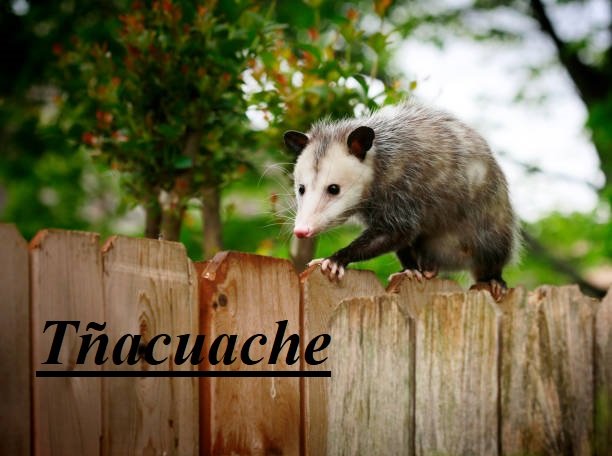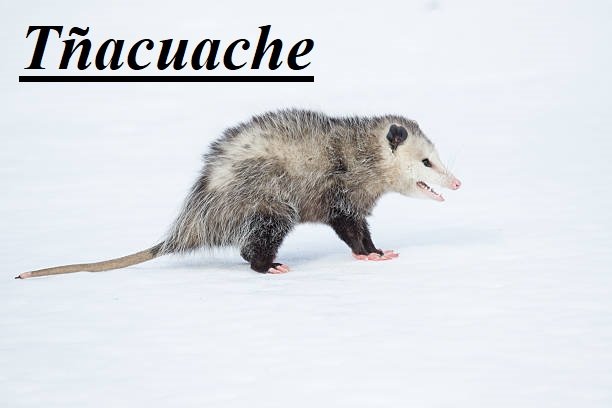Introduction
The tñacuache, commonly recognised in some areas as the opossum, is a captivating marsupial with a unique set of characteristics and behaviours. Known for its nocturnal behaviour and adaptability, the opossum has a huge function in various ecosystems across the Americas. This article explores the unique aspects of the opossum, from its physical features to its ecological significance and cultural significance.
Physical properties
Tñacuaches are easily recognizable due to their amazing physical abilities. They have prehensile tails, which are not the easiest, long and hairless, but also surprisingly practical, helping with climbing and balancing. Their sharp claws are ideal for grasping and climbing trees, while their unique faces feature a white shade with striking black eyes. The coat of the opossum generally varies from grey to white, giving them the camouflaged appearance of their plant habitats. These body features allow opossums to move efficiently in their environment, whether in the bush, undergrowth, or urban environments.
Habitat and distribution
Highly adaptable creatures, tñacuaches thrive in many environments. They are usually seen in forests, agricultural areas and even urban areas at some stage in America. Their adaptability to unique habitats is one of the key factors behind their widespread distribution and survival. They may nest in tree cavities, abandoned burrows, or even in attics or under porches in urban environments. This versatility allows them to live in areas where different animals can war, making them hardy survivors in both natural and human-altered landscapes.
Diet and eating habits
Tñacuaches are omnivores with a relatively diverse diet. They feed on a variety of items along with the bottom line, bugs, small animals and carrion. Their scavenging habits are particularly beneficial to the environment as they help clean up rot and control insect populations. This abundant diet allows them to thrive in a variety of habitats where food availability can be unpredictable. Their potential to eat a wide variety of foods means they play a key role in nutrient recycling and pest protection in their ecosystems.
Reproduction and life cycle
The reproductive cycle of tñacuaches is quite interesting. Female opossums have a remarkably fast gestation length of approximately 12-14 days. After this rapid gestation, they give birth to underdeveloped young that are kept to develop in their mother’s pouch, similar to other marsupials. This bag provides a safe and nurturing environment where young opossums can develop and expand until they are ready to project onto their personal. Typically, an opossum mother can carry up to 13 younger ones in her pouch, although now not all may additionally live to tell the story to adulthood.
Unique adjustments
One of the finest variations of tñacuache is its potential to play lifeless, a behaviour referred to as thanatosis. When threatened, the opossum can imitate the arrival and smell of an unhelpful animal, thereby deterring predators. This unique defence mechanism is incredibly powerful and increases their chances of survival in the wild. In addition, their prehensile tails and sharp claws allow them to properly orient themselves in arboreal environments, improving their ability to break through predators and find food.
Role within the ecosystem
Tñacuaches play a key role in maintaining ecological stability. By controlling insect and rodent populations, they help reduce the spread of disease and damage caused by these pests. Additionally, their scavenging behaviour contributes to cleanliness in their environment by consuming dead animals and decaying stock. This ecological function is essential in both rural and urban environments, in which opossums help manage waste and manage pest populations.
Tñacuaches and disease control
Interestingly, opossums have a natural resistance to positive diseases such as rabies. In addition, their intake of ticks, which are recognized carriers of Lyme disease, makes it possible to control the spread of this disease. Their presence in ecosystems is thus beneficial not only for pest control but also for reducing the vectors of disorders. This exact property makes them crucial allies in public health, as they could help mitigate the development of vector-borne diseases.
Interacting with people
As urbanization spreads, tñacuaches regularly come into contact with humans. Although opossums are often seen as pests due to their leaching in trash cans and various areas, they are usually harmless. They play a vital role in controlling pest populations and maintaining ecological stability even in urban environments. Educating the general public approximately the benefits of opossums can help alleviate conflict and sell coexistence.
Tñacuaches in culture and folklore
In many cultures, full-sized opossums retain symbolic meanings and feature prominently in folklore and mythology. They are regularly depicted as clever and adaptable creatures that reflect their actual behaviour. These cultural memories and logos highlight the important courtship between humans and the tñacuach throughout history. In some traditions, opossums are seen as tricksters or symbols of survival and resilience.
Protection status
Currently, tñacuaches are not considered endangered. Their adaptability and considerable distribution contribute to their solid population. However, the continued destruction of habitats poses a potential danger to their fate. Conservation efforts must be recognized in terms of preserving plant habitats and promoting coexistence in urban areas. Protecting inexperienced spaces and corridors for flora and fauna in cities can help opossum populations and help preserve their ecological role.
Common misconceptions
There are many misconceptions about tñacuaches, such as unfounded fears and myths about their behaviour and health hazards. For example, several people mistakenly believe that all opossums are rabid, regardless of their natural resistance to rabies. Educating the public about the true nature of these animals can help alleviate unnecessary worry and encourage coexistence. Dispelling these myths is vital to promoting informed and kind thinking in the direction of opossums.
Observation of Tñacuaches in the wild
For those interested in seeing opossums, good times are usually around dusk and night, when they are most energetic. Look for them in areas with abundant food resources and natural cover, along with forests, parks, or even backyards with thick flowers. Observing their nocturnal behaviour can provide valuable insights into their daily lives and interactions with their environment.
Tips for living with Tñacuaches
For a peaceful coexistence with opossums, it is essential to stabilize garbage containers, put away food and provide a natural habitat. By taking these steps, unwanted encounters can be minimized and the benefits that opossums bring to the environment can be maximized. Simple measures such as sealing entry points to homes and using wildlife-friendly gardening practices can go a long way in promoting a harmonious coexistence.
Evolutionary history of Tñacuaches
Tñacuaches have a rich evolutionary record that dates back thousands and thousands of years. As marsupials, they belong to a remarkable line of placental mammals, with their closest home often being found in Australia and New Guinea. The presence of opossums in the Americas is the result of historical migrations and diversifications that have allowed these marsupials to thrive in a variety of environments. Studying their evolutionary history provides insight into the adaptability and resilience of marsupials in fashion and highlights their successes in different ecological niches.
Behavioural properties
Tñacuaches exhibit a variety of exciting behaviours outside of thanatosis. Generally speaking, they are nocturnal, spending the nights foraging and the days resting in safe places. Opossums are solitary animals, with each male or female protecting their territory. Despite their solitary nature, they are considered to be quite vocal, using a range of sounds to communicate with each other, along with hissing, growling and clicking. These vocalizations may be used for mating, territory defence, and distress signalling.
Predators and threats
While tñacuaches have numerous options for avoiding predators, they face several threats in the wild. Common predators include owls, foxes, coyotes, and giant snakes. In addition, human activities pose a great threat to the opossums. Urban improvement, habitat destruction and street traffic result in many fatal cases of opossums every 12 months. Conservation efforts should be directed at these threats to ensure the continued survival of these creatures. Actions, along with transitions to the natural world and habitat restoration, can help mitigate these threats.
Research and study
Ongoing research and studies on tñacuaches offer rare facts about their behaviour, physiology and ecological impact. Scientists are particularly curious about their resistance to disturbance and cleaning habits, which have implications for public fitness and environmental control. In addition, citizen technology initiatives play a role in collecting statistics on opossum populations and behaviour and engaging the public in conservation. These investigations contribute to a deeper understanding of opossums and their roles in different ecosystems.
A look into the future for Tñacuaches
The fate of the opossums depends on our ability to mitigate the threats they face and maintain their natural habitat. Urban planning that includes inexperienced areas and corridors for flora and fauna can help opossum populations in cities. Public education, approximately the blessing of the opossums, can also promote coexistence. By taking proactive steps, we ensure that these particular marsupials thrive and contribute to the ecosystems they inhabit. Efforts to defend their habitat and sell public awareness are important to their long-term survival.
Conclusion:
The Tñacuache, with its distinctive appearance and brilliant demeanour, is more than just an unusual sight in many parts of the Americas. Its sentient tail, nocturnal behaviour, and unique defence mechanisms such as thanatosis make it a fascinating challenge to behold and appreciate. Understanding the body and behavioural trends of the opossum makes it easier for us to understand the adaptability and resilience that have allowed it to thrive in many environments, from dense forests to busy urban regions.
In addition to its exciting properties, opossum is essential in maintaining ecological stability. By controlling insect and rodent populations and acting as nature’s cleaning crew, these marsupials contribute significantly to the health of their ecosystems. Their resistance to positive diseases and the ability to limit the spread of Lyme disease by ingesting ticks further underline their importance. Acknowledging these contributions can shift our perception of opossums from mere pests to valuable allies in environmental conservation.
Looking at fate, it is essential to support coexistence and conservation efforts to ensure the continued survival of the opossums. Educating the general public about their benefits, maintaining plant habitats, and incorporating flora and fauna-friendly practices into urban design plans are essential steps. By promoting greater appreciation and awareness of tñacuache, we will help their populations and celebrate their place in the plant world, ensuring that these resilient creatures thrive and contribute to environmental stability.












